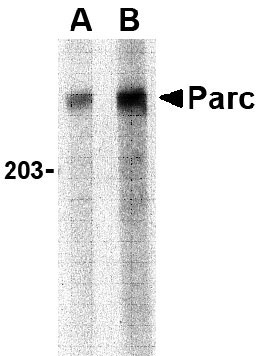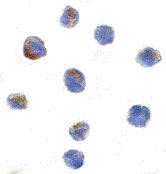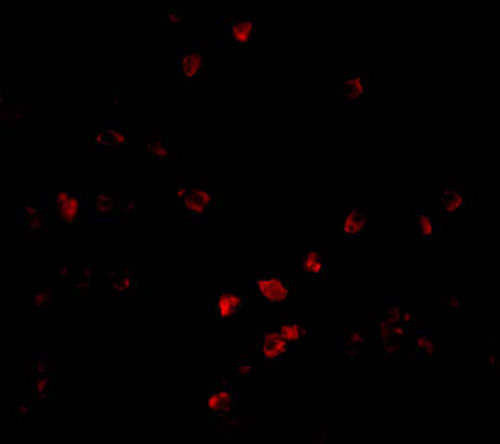PARC Antibody
- SPECIFICATION
- CITATIONS
- PROTOCOLS
- BACKGROUND

Application
| WB, IF, ICC, E |
|---|---|
| Primary Accession | Q8IWT3 |
| Other Accession | NP_055904, 24307991 |
| Reactivity | Human, Mouse |
| Host | Rabbit |
| Clonality | Polyclonal |
| Isotype | IgG |
| Calculated MW | 281229 Da |
| Application Notes | PARC antibody can be used for the detection of PARC by Western blot at 1 - 2 µg/mL. Antibody can also be used for immunocytochemistry starting at 1 µg/mL. For immunofluorescence start at 2 µg/mL. |
| Gene ID | 23113 |
|---|---|
| Other Names | PARC Antibody: PARC, H7AP1, KIAA0708, PARC, Cullin-9, UbcH7-associated protein 1, CUL-9, cullin 9 |
| Target/Specificity | CUL9; |
| Reconstitution & Storage | PARC antibody can be stored at 4℃ for three months and -20℃, stable for up to one year. As with all antibodies care should be taken to avoid repeated freeze thaw cycles. Antibodies should not be exposed to prolonged high temperatures. |
| Precautions | PARC Antibody is for research use only and not for use in diagnostic or therapeutic procedures. |
| Name | CUL9 |
|---|---|
| Synonyms | H7AP1, KIAA0708, PARC |
| Function | Core component of a Cul9-RING ubiquitin-protein ligase complex composed of CUL9 and RBX1 (PubMed:38605244). The CUL9-RBX1 complex mediates ubiquitination and subsequent degradation of BIRC5 and is required to maintain microtubule dynamics and genome integrity. Acts downstream of the 3M complex, which inhibits the ubiquitination of BIRC5 (PubMed:24793696). The CUL9-RBX1 complex also mediates mono- ubiquitination of p53/TP53 (PubMed:38605244). Acts as a cytoplasmic anchor protein in p53/TP53-associated protein complex. Regulates the subcellular localization of p53/TP53 and its subsequent function (PubMed:12526791, PubMed:17332328). Ubiquitinates apurinic/apyrimidinic endodeoxyribonuclease APEX2 (PubMed:38605244). Ubiquitination by the CUL9-RBX1 complex is predominantly mediated by E2 ubiquitin-conjugating enzymes UBE2L3 and UBE2D2 (PubMed:38605244). |
| Cellular Location | Cytoplasm. |
| Tissue Location | Ubiquitously expressed in all tissues with highest expression in testis brain and kidney. |

Thousands of laboratories across the world have published research that depended on the performance of antibodies from Abcepta to advance their research. Check out links to articles that cite our products in major peer-reviewed journals, organized by research category.
info@abcepta.com, and receive a free "I Love Antibodies" mug.
Provided below are standard protocols that you may find useful for product applications.
Background
PARC Antibody: The continued localization of p53 to the nucleus is essential for its function as a tumor suppressor. PARC, a large, Parkin-like ubiquitin ligase has recently been identified as a cytoplasmic anchor protein in p53-associated protein complexes. In the absence of stress, PARC inactivation results in nuclear localization of p53 and activation of p53-dependent apoptosis, while overexpression of this protein promoted cytoplasmic sequestration of p53. Surprisingly, PARC knockout mice were viable and exhibited no obvious phenotype, suggesting that other proteins, such as the highly related cullin family of E3 ubiquitin ligases, may perform similar functions in the absence of PARC. Additionally, it has been suggested that p53 binding to PARC may serve to control PARC function.
References
Nikolaev AY, Li M, Puskas N, et al. Parc: a cytoplasmic anchor for p53. Cell 2003; 112:29-40.
Skaar JR, Arai T, and DeCaprio JA. Dimerization of CUL7 and PARC is not required for all CUL7 functions and mouse development. Mol. Cell. Biol. 2005; 25:5579-89.
If you have used an Abcepta product and would like to share how it has performed, please click on the "Submit Review" button and provide the requested information. Our staff will examine and post your review and contact you if needed.
If you have any additional inquiries please email technical services at tech@abcepta.com.













 Foundational characteristics of cancer include proliferation, angiogenesis, migration, evasion of apoptosis, and cellular immortality. Find key markers for these cellular processes and antibodies to detect them.
Foundational characteristics of cancer include proliferation, angiogenesis, migration, evasion of apoptosis, and cellular immortality. Find key markers for these cellular processes and antibodies to detect them. The SUMOplot™ Analysis Program predicts and scores sumoylation sites in your protein. SUMOylation is a post-translational modification involved in various cellular processes, such as nuclear-cytosolic transport, transcriptional regulation, apoptosis, protein stability, response to stress, and progression through the cell cycle.
The SUMOplot™ Analysis Program predicts and scores sumoylation sites in your protein. SUMOylation is a post-translational modification involved in various cellular processes, such as nuclear-cytosolic transport, transcriptional regulation, apoptosis, protein stability, response to stress, and progression through the cell cycle. The Autophagy Receptor Motif Plotter predicts and scores autophagy receptor binding sites in your protein. Identifying proteins connected to this pathway is critical to understanding the role of autophagy in physiological as well as pathological processes such as development, differentiation, neurodegenerative diseases, stress, infection, and cancer.
The Autophagy Receptor Motif Plotter predicts and scores autophagy receptor binding sites in your protein. Identifying proteins connected to this pathway is critical to understanding the role of autophagy in physiological as well as pathological processes such as development, differentiation, neurodegenerative diseases, stress, infection, and cancer.




